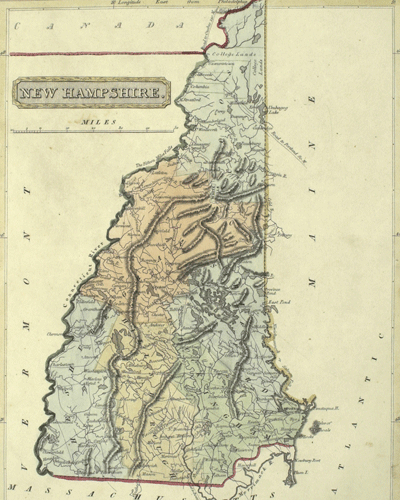Results navigation
2. New Hampshire 1787 State Senate, Grafton County
3. New Hampshire 1787 State Senate, Hillsborough County
4. New Hampshire 1787 State Senate, Rockingham County
5. New Hampshire 1787 State Senate, Strafford County
6. New Hampshire 1788 Electoral College
7. New Hampshire 1788 President
8. New Hampshire 1788 Registry of Deeds, Strafford County
9. New Hampshire 1788 State Senate, Cheshire County
10. New Hampshire 1788 State Senate, Grafton County
Results navigation

Attitudes toward New Hampshire's form of government were shaped by the state's relationship with England and by a series of royal governors. The debate erupted in the mid-1770s and continued during the war. The fundamental ideological disagreement focused on local control versus state authority. Moreover, the competition for power among three distinct regions of New Hampshire (the seacoast and Piscataqua Valley, Merrimack Valley, and the Connecticut River Valley) animated the public debate further.
Before passage of the Declaration of Independence in 1776, New Hampshire was the only province in New England without a formal charter of incorporation. New Hampshire was without legal government when the last royal governor, John Wentworth, fled in the summer of 1775 and the personal safety and future of Loyalists was in question. New Hampshire declared its independence six months before the signing of the Declaration of Independence on July 4.
The Federalists, an elite party concerned about commercial interests and monetary policy for the new nation, regained power in New Hampshire in 1813 under John Taylor Gilman, who did not cooperate with President Madison's administration and did not support the war. Power for the Federalists was short-lived, as a declining economy lead to the resurgence of the Republican Party after the war.
The nature of state government that evolved in New Hampshire during the nationalization of America had its roots in the desire to impose checks on state control, creating a political structure that was and continues to be decentralized. The governor heads a weak executive branch held in check to this day by a five-member Executive Council elected from five regions of the state. Moreover, the large House of Representatives, known as the General Court (400 members), ensures strong local representation and is the third largest legislative body in the world after Parliament and the United States Congress. A 24-member state Senate rounds out a bicameral legislative body.
New Hampshire remains one of two states with two-year terms for governor, for members of the Executive Council, and for legislative office. The struggle in the early national period focused on local control, on limiting state and federal power, and on the proper distribution of authority. Although New Hampshire became the keystone of the federal government by voting as the ninth and ratifying state to adopt the United States Constitution in 1789, it has always cast a wary eye on federal power over states and on state power over local government.
Local elections of delegates and representatives to constitutional conventions included the tactic of "binding instructions" to ensure that local representation would not be sacrificed to the state or federal government. This proved unpopular because a constitutional convention requires public discussion and reasoned decisions based on varying points of view raised at the convention. Hence the delegates need flexibility, not binding instructions. However, New Hampshire's political culture continues to be steeped in the desire to preserve local, community interests. The method of voting began with voice votes at town meetings, but by 1804 New Hampshire had directed in state statute that town clerks be chosen by ballot. Ballots were hand written, although by the 1830s, printed ballots came into use.
Early in the new republic, the right to vote reflected the tension between the Federalists, those property owners with a "stake in society," and the Republicans (Democratic-Republicans), who wanted to expand democratic participation as broadly as possible—so broadly, in fact, that some feared "mob rule" at the other end of the spectrum. By 1800 New Hampshire was one of just three states (the others were Kentucky and Vermont) that had universal white manhood suffrage, having done away with the requirement of property ownership. All of New England except Connecticut allowed African Americans to vote without significant restriction. New Hampshire endorsed the principle that the more people taking part in the democratic process, the better. This engaged political culture continues to this day, with high voter participation in New Hampshire's well-known first-in-the-nation presidential primary.
Bibliography
- Daniell, Jere R. 1981.
Colonial New Hampshire—A History. Millwood, NY: KTO Press. - Gardner, William M., Mevers, Frank C., Upton, Richard F. 1989.
New Hampshire: The State That Made Us A Nation. Portsmouth, NH: Peter E. Randall Publisher. - Turner, Lynn Warren. 1983.
The Ninth State: New Hampshire’s Formative Years. Chapel Hill: University of North Carolina Press.






